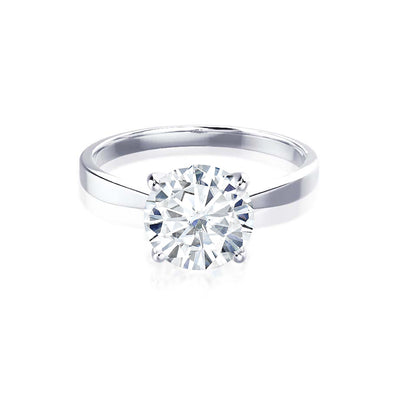In recent years, lab-grown diamonds have emerged as an ethical alternative to traditional mined diamonds. These diamonds are chemically, physically, and optically identical to their natural counterparts, but their production process raises important questions about environmental impact, human rights, and economic fairness. Choosing a lab-grown diamond ring represents a conscious decision to support sustainable practices and a more ethical approach to luxury. Understanding the ethical implications of lab-grown diamonds, and the impact of choosing one over a mined diamond, is crucial for consumers who want their purchase to align with their values.
The Environmental Impact
One of the primary ethical concerns surrounding traditional diamond mining is its environmental consequences. Mining for diamonds can have significant environmental repercussions. Large-scale diamond extraction often requires the removal of massive amounts of earth, leading to deforestation, soil erosion, and the destruction of ecosystems. Moreover, mining operations use vast amounts of water and energy, contributing to pollution and waste. The carbon footprint of diamond mining is substantial, with emissions released during the extraction and transportation processes.
Lab-grown diamonds such as designs by ethical jeweller, Lily Arkwright, on the other hand, are produced in controlled environments using cutting-edge technology that mimics the natural diamond-forming process. These diamonds are created using either High Pressure High Temperature (HPHT) or Chemical Vapor Deposition (CVD) methods, both of which require significantly less land disturbance compared to mining. Although the energy used in the production of lab-grown diamonds can be substantial, advancements in renewable energy sources are helping to reduce their environmental impact. As the lab-grown diamond industry continues to grow, it is increasingly incorporating more sustainable practices, making them a more eco-friendly option than their mined counterparts.
Human Rights and Labor Conditions
The ethical concerns surrounding diamond mining extend beyond environmental damage to human rights violations and exploitative labor practices. In regions like Africa, where many of the world’s diamonds are mined, there have been widespread reports of child labor, unsafe working conditions, and even armed conflict funded by the diamond trade. These “blood diamonds” are a symbol of the severe human toll caused by the diamond industry.
By choosing a lab-grown diamond ring, consumers can avoid contributing to this cycle of exploitation. Lab-grown diamonds are created in controlled, ethical environments where workers are typically paid fair wages and work in safe, regulated conditions. As a result, consumers can be assured that their diamond purchase does not contribute to the harm caused by mining operations, providing peace of mind in knowing their investment has not been tied to human suffering.
Cost and Affordability
Another important ethical consideration in choosing between lab-grown and mined diamonds is the cost. Mined diamonds are typically much more expensive due to their rarity and the costs associated with their extraction. Lab-grown diamonds, by contrast, are often more affordable, as their production costs are generally lower. This makes them an attractive option for consumers who wish to own a high-quality diamond without the high price tag.
The affordability of lab-grown diamonds can also help to democratize access to luxury goods. Many individuals who may have been priced out of the diamond market can now consider purchasing a diamond ring without compromising their values. The cost savings can also extend to other parts of the jewelry industry, where consumers can opt for larger or more intricate pieces while still staying within budget.
Transparency and Traceability
One of the most compelling ethical reasons to opt for a lab-grown diamond is the increased transparency and traceability in the supply chain. Mined diamonds can be difficult to trace, particularly when they pass through several intermediaries before reaching consumers. This opacity makes it challenging for consumers to verify that their diamonds were ethically sourced.
In contrast, lab-grown diamonds come with detailed information about their production, including the technology used and the environmental impact of their creation. Many companies offer certifications and guarantees that the diamonds are conflict-free and produced under ethical working conditions. This level of transparency allows consumers to make an informed decision and take pride in the knowledge that their purchase supports ethical practices.
Changing Consumer Preferences
As awareness of the ethical implications of diamond mining grows, more consumers are turning to lab-grown diamonds as an ethical choice. Younger generations, in particular, are more likely to prioritize sustainability and social responsibility in their purchasing decisions. With the rise of conscious consumerism, the demand for lab-grown diamonds is expected to continue to increase.
The shift toward lab-grown diamonds is not just a trend but a reflection of changing attitudes toward luxury and material wealth. Consumers are increasingly seeking products that align with their values and contribute to a more sustainable and ethical world. By choosing a lab-grown diamond ring, individuals can make a powerful statement about their commitment to ethical practices, environmental responsibility, and social justice.
Conclusion
The ethics behind choosing a lab-grown diamond ring go far beyond the aesthetic appeal of the gem itself. Consumers who choose lab-grown diamonds are making a conscientious decision to support sustainability, fair labor practices, and environmental responsibility. By avoiding the harmful impacts of diamond mining, they can enjoy a beautiful and ethical alternative that aligns with their values.

